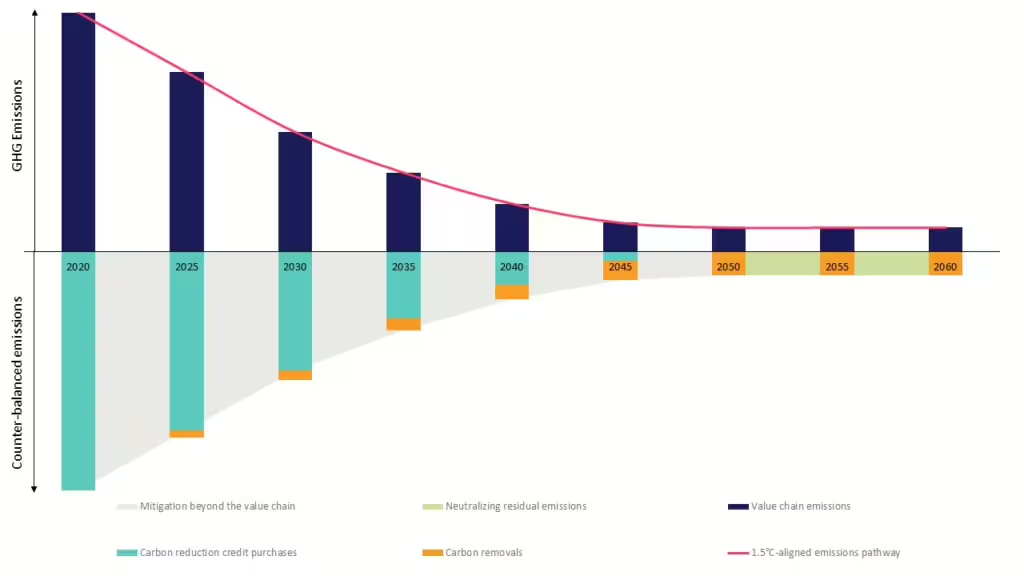Authors
Neal Gray-Wannell, Manager, CCS and Removals, WBCSD, Christiaan Gevers Deynoot, Senior Manager Carbon Removals Platform, South Pole
The science is irrefutable – it is necessary to drastically and urgently reduce greenhouse gas emissions to limit global warming to 1.5°C.[1] However, it is also becoming increasingly clear that reducing emissions will not be enough: removing significant quantities of carbon dioxide from the atmosphere will also be key.
A range of nature-based and technological solutions are available to remove carbon from the atmosphere. These are predominantly, though not exclusively, financed through crediting schemes in carbon markets. Recent media coverage has focused on the debate around natural and technological solutions’ relative importance and the topic of carbon credits more broadly. Common criticisms focus on the credibility of corporate claims from the use of carbon credits as well as the quality of the crediting accounting frameworks. While these are important issues that need to be addressed, investment in carbon removals, through purchasing credits or other means, is still key to achieving ‘global’ net zero emissions as quickly as possible.
This article highlights the vital role that carbon removals can play in corporate climate strategies and calls on businesses to consider developing a portfolio of climate mitigation solutions beyond the value chain, including a diverse range of nature-based and technological removal solutions.
The role of carbon removals in corporate climate strategies
For a company to achieve net zero carbon emissions by 2050 at the latest, it needs to reduce emissions in its own operations and actively support the decarbonization of its suppliers and customers. Under the Science Based Target Initiative’s (SBTi) Corporate Net Zero Standard, those companies wishing to establish near and long-term targets aligned with a global warming scenario of 1.5°C must reduce value chain emissions to a residual level of no more than 10% of a baseline at net zero by 2050 or earlier.
Most companies are not allowed to use carbon removals to claim progress against interim decarbonization targets, except for those in the forest, land use and agriculture sector where the removal takes place in the company’s supply chain. This is to ensure that emission reduction activities are prioritized. Carbon removals instead feature in two other key elements of a company’s net-zero journey – neutralizing residual emissions at net zero and in “beyond value chain mitigation.”
Companies must neutralize their residual emissions at and beyond the point of net zero by purchasing an equivalent quantity of permanent removals. These investments can be either through purchasing removals credits or through in-value chain removals activities. The permanency of these removals is currently open to interpretation, though work to define permanence is ongoing. There is a growing movement toward achieving fossil emission neutralization at net zero through durable, technological removals to attain permanent climate stabilization and avoid putting undue pressure on land use. This mustn’t undermine the continued value of Natural Climate Solutions (NCS) at and beyond net zero. There will still be a significant role for the neutralization of residual emissions from the land use sector and to generate additional environmental and social benefits.
Companies should also invest in carbon removals as part of what SBTi calls “beyond value chain mitigation”. This is where companies voluntarily engage in climate mitigation activities outside their value chain, such as purchasing carbon credits, to counter-balance unabated emissions on the journey to net zero emissions. The recent “Integrity Matters” report from the UN High-Level Expert Group (HLEG) emphasized the importance of this activity to help drive broader global climate action and help companies make carbon neutrality claims on the path to net zero. These investments can be associated with projects that either lead to reduced carbon emissions or carbon removal. Companies need to consider developing portfolios that consider both solutions. There is currently limited formal guidance on relative proportions, though SBTi currently recommends prioritizing projects that restore and enhance natural carbon sinks to protect remaining intact ecosystems in the near term. However, companies should start to invest in technological removal solutions in parallel. These solutions are still relatively nascent, and rapid growth in investment is needed to overcome the significant techno-economic challenges preventing these solutions from being deployed at scale to help achieve global net zero emissions.
Some companies may wish to invest in removals enough to become net-negative, or “climate positive”, at, or after, the point of net zero. The Intergovernmental Panel on Climate Change (IPCC) identified that carbon negativity will be key to mitigating an expected overshoot in the global carbon budget associated with keeping average global warming to 1.5°C. A handful of leading companies have set carbon-negative targets, meaning they will remove from the atmosphere all the carbon they have emitted either directly or indirectly since their creation. There is no standard approach for verifying this at present or for deciding which carbon removals solutions can be used. The standardization of science-based carbon accounting approaches and carbon-negative claims practices could ensure this, while creating a new demand signal to spur on private sector investment.
Figure 1: An example of a corporate net-zero pathway

What solutions are there and how do they differ?
There are many different forms of carbon removal solutions at varying stages of development. Examples of nature-based removals include afforestation and soil carbon sequestration. Examples of technological solutions include biochar, biomass with carbon removal and storage (BECCS) and direct air capture, and carbon storage (DACCS). There is a diverse range of attributes that apply across all solutions. These include cost, technological readiness and climate impacts, such as durability and changes to albedo (a measure of how reflective the Earth’s surface is).
They also have different non-climate impacts, such as competition for resources, biodiversity impacts, and support for local communities and indigenous peoples. These are typically positive for NCS and are consequently often labeled as core benefits. However, these may be negative for some, particularly technological solutions. For example, in order for them to operate, direct air capture facilities consume significant quantities of renewable energy to operate that could theoretically be used elsewhere for direct electrification. Such displacement effects must be accounted for.
To make investment decisions between different removals solutions, it is critical to understand their respective attributes, ramifications and particular investment needs to justify different price points. The most critical element that defines a solution’s climate impact over time is its storage durability – a measure of permanence and the risk of reversibility (re-emission). A common debate on removals focuses on the fundamental durability differences between nature-based and technological removals.
However, although it is key to justify pricing based on differences in durability, in line with the aim of permanently removing carbon, this must not disincentivize investment into less durable removal types that are still paramount to short-term climate mitigation. This will buy necessary time, or “carbon budget”, as society decarbonizes while the more durable solutions are scaled up. It also shouldn’t undermine the value of the wide variety of environmental and social co-benefits that some removal solutions can provide. Each carbon removal solution offers a unique set of benefits beyond removing carbon.
The importance of a diversified carbon removals portfolio
Deciding on which carbon removals to invest in can be daunting – there are many methods with a plethora of different characteristics. Rather than investing in a single or limited set of solutions, a portfolio approach to investing in a diverse range of both nature-based and technological removals will allow for synergies and counteract the tradeoffs between the different solutions.
Key benefits of this approach include:
- Initial prioritization of more readily available NCS will help to restore natural ecosystems while also starting to remove carbon from the atmosphere at scale.
- Portfolios that also include gradually increased investment in technological removals will help to drive the innovation needed for them to be deployed at the scale necessary to reach net zero emissions by 2050.
- The various co-benefits across the different solutions can be maximized to help companies achieve progress against broader corporate sustainability targets.
- Solutions that emerge as the most effective and that meet the requirements of future compliance markets will be sufficiently well-developed to be more commercially viable.
- The potential risks or negative impacts of different solutions can be spread across the portfolio.
WBCSD helps companies navigate this confusing and fast-moving space by developing removals investment guidance which includes a science-based framework to objectively compare different forms of removals across both nature and technology.
As a next step, WBCSD will develop high-level guidance on developing a beyond-value chain mitigation portfolio which will provide blueprints on the relative contributions of different carbon reduction and removal solutions. This will help companies create ambitious and diverse portfolios that will drive broader climate action to achieve global net zero emissions.
If you are interested in finding out more, please contact: gray-wannell@wbcsd.org
[1] Carbon dioxide removal projects are activities initiated by humans that result in a net removal of CO2 from the atmosphere, with the CO2 durably stored in a sink. This CO2 storage will typically undergo a period of monitoring and verification to ensure that the CO2 has not been re-emitted. These sinks can be biogenic, ocean-based or geospheric. Two defining features of a removal solution are the removal mechanism (e.g., land-based biological, geochemical or chemical) and the storage medium (e.g., biomass, product or geologic).
Outline
